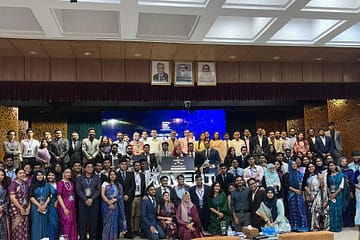Future of Business: E-commerce & Retail [P-1]
Md. Joynal Abdin, BBA (Hons.), MBA
Founder & CEO, Trade & Investment Bangladesh
The future of business in the realms of e-commerce and retail is a fascinating and transformative landscape, driven by a confluence of technological innovations, shifting consumer expectations, and dynamic market trends. As we venture into this new era, several key segments are poised to redefine the way commerce operates, promising a more connected, personalized, and sustainable shopping experience.
Omnichannel retail integration stands out as a pivotal force shaping the future. The traditional boundaries between physical and online stores are fading as businesses increasingly recognize the need for a seamless, integrated shopping journey. Consumers today expect a unified experience, whether they are browsing through a physical store, exploring a website, or using a mobile app. The businesses that successfully bridge these channels will not only meet these expectations but also foster a stronger connection with their customers.
Personalized shopping experiences represent another frontier in the evolution of e-commerce and retail. With the aid of sophisticated data analytics and artificial intelligence, businesses can now tailor their offerings to individual preferences and behaviors. The era of one-size-fits-all marketing is giving way to hyper-personalization, where recommendations, promotions, and content are finely tuned to meet the unique needs of each customer.
Moreover, a growing emphasis on sustainable and ethical retail practices is reshaping the industry’s ethos. Consumers, increasingly conscious of the environmental and social impact of their purchases, are gravitating towards businesses that prioritize sustainability and ethical sourcing. This shift not only reflects a change in consumer values but also presents an opportunity for businesses to align themselves with a greater sense of purpose.
As we look ahead, technologies such as augmented reality (AR) and virtual reality (VR) are poised to revolutionize the shopping experience, allowing customers to visualize products in immersive ways before making a purchase. Artificial intelligence (AI) is becoming a linchpin in retail operations, optimizing everything from inventory management to customer service, while contactless commerce and payment methods continue to gain traction, driven in part by the need for safety and convenience in a post-pandemic world.
In this ever-evolving landscape, businesses that embrace these trends and innovations will not only survive but thrive in the future of e-commerce and retail. The ability to adapt, integrate technology seamlessly, and prioritize customer-centric strategies will be the cornerstone of success in this dynamic and exciting business frontier.
Types of E-commerce Business:
The classification of e-commerce and retail businesses is a nuanced endeavor, given the diverse nature of products, services, and operational models within this dynamic sector. This classification is often based on the nature of transactions, the parties involved, and the platforms used. Here, we delve into four primary classifications that encapsulate the breadth and depth of e-commerce and retail: B2C, B2B, C2C, and M-commerce.
- B2C (Business-to-Consumer): B2C e-commerce refers to transactions conducted directly between a business and individual consumers. In this model, businesses sell products or services directly to end-users through online platforms or traditional retail channels. Examples include online retailers like Amazon, fashion brands with e-commerce stores, and electronics stores selling directly to consumers.
B2C transactions are typically characterized by relatively small purchase volumes, a wide variety of products, and a focus on creating a seamless and user-friendly customer experience. Marketing efforts often target individual consumers, aiming to attract and retain a broad customer base.
- B2B (Business-to-Business): B2B e-commerce involves transactions between businesses. In this model, one business sells products or services to another for use in their operations or for resale. Examples include manufacturers selling raw materials to other businesses, software companies licensing their products to enterprises, and wholesalers supplying products to retailers.
B2B transactions often involve larger volumes, longer sales cycles, and a focus on building lasting business relationships. The purchasing decision may involve multiple stakeholders, and the emphasis is on providing solutions that meet the specific needs of the buying business.
- C2C (Consumer-to-Consumer): C2C e-commerce involves transactions between individual consumers. In this model, individuals sell products or services directly to other consumers through online platforms. Examples include online marketplaces like eBay and classified ad websites where individuals can buy and sell used goods.
C2C transactions are typically decentralized, with individuals acting as both buyers and sellers. Trust and reputation systems play a crucial role, and platforms facilitate transactions while providing a space for individuals to connect and transact.
- M-commerce (Mobile Commerce): M-commerce refers to transactions conducted through mobile devices, such as smartphones and tablets. It encompasses a variety of e-commerce models, including B2C, B2B, and C2C, but with a specific focus on mobile platforms.
M-commerce leverages the convenience and ubiquity of mobile devices, allowing users to shop, pay, and engage with businesses on the go. Mobile apps, mobile-optimized websites, and mobile payment systems are key components of the M-commerce landscape.
These classifications provide a broad framework for understanding the diverse landscape of e-commerce and retail businesses. It’s important to note that many businesses may operate in multiple categories, and the lines between these classifications can blur as the industry continues to evolve. Additionally, emerging trends, such as social commerce and voice commerce, contribute to the dynamic nature of this sector, continually expanding the ways in which businesses and consumers interact in the digital marketplace.
Basic Infrastructure of E-commerce:The basic infrastructure of e-commerce encompasses a variety of technological, logistical, and operational components that work together to facilitate online transactions and provide a seamless shopping experience for users. From website development to secure payment gateways, the infrastructure of e-commerce is critical for the success and efficiency of online businesses. Here’s an overview of the key elements:
- Website and User Interface: The foundation of e-commerce infrastructure is a well-designed and user-friendly website. This includes a visually appealing interface, intuitive navigation, and clear product displays. The website should be responsive, ensuring a consistent and optimized experience across various devices.
- E-commerce Platform: Businesses often use specialized e-commerce platforms or content management systems (CMS) tailored for online retail. Platforms like Shopify, Magento, WooCommerce, and others provide tools for inventory management, order processing, and customization to meet the unique needs of e-commerce businesses.
- Product Catalog and Inventory Management: An effective e-commerce infrastructure includes a robust product catalog system that allows businesses to showcase their products with detailed descriptions, images, and pricing. Inventory management ensures real-time updates on product availability, preventing overselling and backorders.
- Shopping Cart and Checkout Process: The shopping cart is a fundamental component that enables users to add products, review their selections, and proceed to checkout. The checkout process should be streamlined, secure, and user-friendly, with multiple payment options to cater to diverse customer preferences.
- Payment Gateway: A secure payment gateway is essential for processing online transactions. This infrastructure component encrypts sensitive financial information, ensuring the safety of customer data. Popular payment gateways include Stripe, PayPal, and Square.
- Security Measures: Security is a paramount concern in e-commerce infrastructure. SSL (Secure Socket Layer) certificates encrypt data transmitted between the user’s browser and the server, protecting against unauthorized access. Regular security audits, firewalls, and other measures are implemented to safeguard customer information.
- Logistics and Order Fulfillment: The logistics infrastructure involves partnerships with shipping carriers, order fulfillment centers, and effective supply chain management. Seamless integration between the e-commerce platform and logistics partners ensures accurate tracking, timely deliveries, and efficient order fulfillment.
- Customer Relationship Management (CRM) System: A CRM system helps businesses manage customer interactions, track purchasing behavior, and personalize communication. This infrastructure component contributes to building customer loyalty and enhancing the overall shopping experience.
- Analytics and Reporting: E-commerce businesses rely on analytics tools to gather insights into user behavior, website performance, and sales data. This information is invaluable for making data-driven decisions, optimizing marketing strategies, and improving the overall e-commerce infrastructure.
- Responsive Customer Support: A responsive customer support infrastructure, including live chat, email, and phone support, is crucial for addressing customer inquiries, concerns, and issues promptly. Excellent customer service contributes to positive user experiences and repeat business.
Building a robust e-commerce infrastructure involves careful consideration of each of these components, ensuring they work seamlessly together to create a secure, efficient, and user-friendly online shopping environment. As technology continues to advance, e-commerce businesses must stay adaptable and incorporate innovations to meet evolving customer expectations.
To Read 2nd Part of this Article, Click Here!
Future of Business: E-commerce & Retail [P-1] // Future of Business: E-commerce & Retail [P-1]
Mr. Md. Joynal Abdin is a Business Consultant & Digital Marketer based in Dhaka, Bangladesh. He is Founder & CEO of Trade & Investment Bangladesh, one of the leading Business Consultancy Firm in Bangladesh. He is also Co-Founder & CEO of Bangladesh Trade Center. Previously he served at Dhaka Chamber of Commerce & Industry (DCCI) as Executive Secretary; DCCI Business Institute (DBI) as Executive Director; SME Foundation as Deputy Manager; and the Federation of Bangladesh Chambers of Commerce & Industry (FBCCI) as Assistant Secretary.
The list of services Mr. Abdin is offering includes but not limited to Business Mentorship, Business Research and Documentations like Feasibility Study, Project Proposal Preparation, Writing Business Manual, Standard Operating Procedures etc.; Export Market Selection and Product Positioning at Home and Abroad; Buyers-Sellers Matchmaking; Website Development; Search Engine Optimization (SEO); and Social Media Marketing etc.

![Future of Business: E-commerce & Retail [P-1]](https://ml7cz6qg98az.i.optimole.com/w:750/h:750/q:mauto/ig:avif/https://mdjoynalabdin.com/wp-content/uploads/2023/10/2.-Business-Mentorship-1-1024x1024.webp)




0 Comments